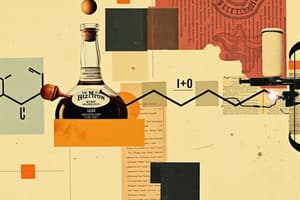Podcast
Questions and Answers
What is the general structure of an ether?
What is the general structure of an ether?
- R–S–R
- R–COOH
- R–O–R (correct)
- R–OH
Which compound is used industrially as a solvent?
Which compound is used industrially as a solvent?
- Tetrahydrofuran
- Diethyl ether (correct)
- Methanol
- Ethanol
What is the bond angle in dimethyl ether?
What is the bond angle in dimethyl ether?
- 112° (correct)
- 120°
- 109.5°
- 180°
What gives ethers a slight dipole moment?
What gives ethers a slight dipole moment?
Thiols and sulfides are sulfur analogs of which functional groups?
Thiols and sulfides are sulfur analogs of which functional groups?
Flashcards are hidden until you start studying
Study Notes
General Structure of Ethers
- Ethers possess a general structure characterized by an oxygen atom bonded to two alkyl or aryl groups, represented as R-O-R'.
- This structure creates a simple functional group, differentiating ethers from other organic compounds.
Industrial Solvent
- Dimethyl sulfoxide (DMSO) is commonly used as an industrial solvent due to its ability to dissolve a wide range of polar and nonpolar compounds.
- Its effectiveness makes it vital for various chemical reactions and processes.
Bond Angle in Dimethyl Ether
- The bond angle in dimethyl ether is approximately 110 degrees, reflecting its bent molecular geometry due to the presence of the oxygen atom.
- This angle is slightly less than the typical tetrahedral angle of 109.5 degrees found in alkanes.
Dipole Moment in Ethers
- Ethers exhibit a slight dipole moment mainly due to the electronegativity difference between the oxygen atom and the carbon atoms to which it is bonded.
- This polarity allows ethers to interact favorably with polar solvents and other molecules.
Functional Group Analogs
- Thiols and sulfides serve as sulfur analogs of alcohols and ethers, respectively.
- This similarity arises from the replacement of the oxygen atom in these functional groups with sulfur, affecting their chemical properties and behaviors.
Studying That Suits You
Use AI to generate personalized quizzes and flashcards to suit your learning preferences.




